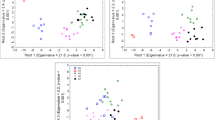Abstract
Twenty varieties of maize (Zea mays, Poaceae) were studied through 11 attributes in three to seven randomly selected plants of each variety with a view to understanding the effect of cob characters on technologically desirable grain qualities. Canonical discriminant analysis showed thatproductivity (determined by total grain weight/cob, cob diameter and average grain weight) was the most discriminating among varieties followed by round grains fraction (represented by whole top and middle flat grains, number of rows and grain count/surface area), middle flat grains (composed of middle flat grains and grain count/surface area) and shape of the cob (determined by shape index, total grain weight/cob and cob diameter), which accounted for 35.1, 18.3, 12.2, and 9.8% of the total variance, respectively. In the light of these results, tentative norms have been suggested to evolve maize varieties of superior technological properties and yet retain high productivity. A cylindrical cob of large diameter with highest number of grains/area and smallest possible number of rows together constituted an ideal combination to achieve the objectives. Such possibilities in the light of available information are discussed.
Zusammenfassung
Man hat 11 Charakteristiken (oder Eigenschaften) von 20 Maisarten (Zea mays, Poaceae) mittels 3–7 zufällig gewählter Pflanzen jeder Art studiert. Das Ziel war zu einem Verständnis der Wirkung von Kolbencharakteristiken auf die technologisch wünschbaren Korneigenschaften zu gelangen. Eine kanonische Diskriminantenanalyse zeigte, dass Produktivität (bestimmt mit Hilfe von Korngewicht/ Kolben, Kolbendurchmesser, und mittlerem Korngewicht) war höchst diskriminant; nächst kamen, der Reihe nach, die Rundkornfraktion (durch ganze Ober- und Mittelkörner, Reihenanzahl, und Anzahl von Körnern pro Flächeneinheit dargestellt), flache Mittlerekörner (bestehend aus flachen Mittlerekörnern und Körneranzahl/Flächeneinheit) und Kolbenform (mittels Formindex, gesamtes Körnergewicht/Kolben, und Kolbendurchmesser bestimmt); die obigen Parameter stellen 35.1, 18.3, 12.2, bzw. 9.8% der gesamten Varianz dar. Aus diesen Messungen ist man zum Schlusse gekommen, dass ein zylindrischer Kolben mit der grössten Körneranzahl pro Flächeneinheit, und möglichst kleinen Reihenanzahl, eine ideale Kombination darstellt. Verschiedene Möglichkeiten werden im Lichted dieser Kenntnisse diskutiert.
Similar content being viewed by others
Literature Cited
AOAC. 1980. Official method of analysis. 13th ed. Association of Official Analytical Chemists, Washington, DC. [Method 14.004]
Cooley, W. W., and P. R. Lohnes. 1971. Multivariate data analysis. John Wiley and Sons, New York.
Duvick, D. N. 1986. Plant breeding: past achievements and expectations for the future. Econ. Bot. 40:289–297.
Gray, D., and T. H. Thomas. 1982. Seed germination and seedling emergence as influenced by the position of development of the seed on, and chemical applications to, the parent plant. Pages 81–110in A. A. Khan, ed., The physiology and biochemistry of seed development, dormancy and germination. Elsevier Biomedical Press, Amsterdam.
Leonard, W. H., and J. H. Martin. 1963. Cereal crops. Macmillan, New York.
Narasimha, H. V., M. K. Bhashyam, G. N. Raju, S. Sreedhara Murthy, and T. Srinivas. 1987. Effect of size and shape on milled product quality in maize. Poster paper (No. QAC 19) presented in VII Indian Convention of Food Scientists and Technologists, Central Food Technological Research Institute, Mysore, India.
Pe’, E., E. Ottoviano, and A. Camussi. 1982. Structural analysis of relationships between ear and plant traits in maize. Maydica 27:41–53.
Pomeranz, Y., C. R. Martin, D. D. Taylor, and F. S. Lai. 1984. Corn hardness determination. Cereal Chem. 61:147–150.
—,Z. Czuchajowska, and F. S. Lai. 1986. Gross composition of coarse and fine fractions of small corn samples ground on the Stenvert hardness tester. Cereal Chem. 63:22–26.
Sprague, G. F. 1955. Corn and corn improvement. Academic Press, New York.
Stanley, S.A. 1987. Structure and composition. Pages 53–82in S. A. Watson and P. E. Ramstad, eds., Corn chemistry and technology. American Association of Cereal Chemists, St. Paul, MN.
Zuber, M. S., and L. L. Darrah. 1987. Breeding, genetics and seed corn production. Pates 31–51in S. A. Watson and P. E. Ramstad, eds., Corn chemistry and technology. American Association of Cereal Chemists, St. Paul, MN.
Author information
Authors and Affiliations
Rights and permissions
About this article
Cite this article
Srinivas, T., K. Bhashyam, M., Chand, N. et al. Relationship of Cob characters with Grain Morphology in Maize (Zea mays, Poaceae). Econ Bot 45, 503–510 (1991). https://doi.org/10.1007/BF02930714
Received:
Accepted:
Issue Date:
DOI: https://doi.org/10.1007/BF02930714




